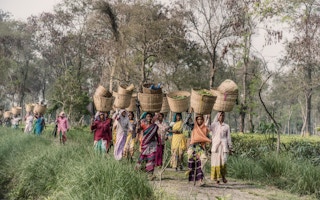From teen activist Greta Thunberg’s much-publicised transatlantic journey on a zero-emissions boat to attend the United Nations General Assembly to the proliferation of climate protests, the world is more aware than ever of the climate threat.
Yet this increased awareness has yet to translate into collective action by world leaders to mitigate climate change, let alone targeted efforts to protect the most vulnerable groups – beginning with women and girls.
The facts speak for themselves. Women are likelier than men to live in poverty, and gendered social roles that reproduce socioeconomic power imbalances leave women and girls particularly vulnerable to a wide variety of climate consequences, including reduced access to water, food, shelter, and vital services.
Not surprisingly, 80 per cent of people displaced by climate change are women. Moreover, women are more likely than men to suffer from increased workload and income loss due to climate disasters. In South Sudan – one of the world’s fastest-warming countries – droughts and flooding have forced girls and women to walk farther to gather firewood and obtain water, a time-consuming and potentially dangerous change.
As meeting households’ energy, water, and food needs becomes more difficult, girls are often taken out of school or married off at a young age. This exacerbates existing inequalities and entrenches these girls’ vulnerability.
Women are also more likely to face climate-sensitive health consequences, such as undernutrition and malaria, and to die in natural disasters, such as droughts and floods. An Oxfam report found that in India, Indonesia, and Sri Lanka, surviving men outnumbered surviving women by almost three to one after the 2004 tsunami.
During the 2015 earthquake in Nepal, many pregnant women were unable to reach health centers, increasing their risk of complications or even death.
“
We cannot address the climate crisis without tackling the gender-equality crisis.
The World Health Organization reports that the effects of gender on life expectancy in natural disasters tend to be larger in more severe disasters, and where women’s socioeconomic status is lower. In other words, we cannot address the climate crisis without tackling the gender-equality crisis.
Make no mistake: there is indeed a gender-equality crisis. Our partnership, Equal Measures 2030, recently launched the SDG Gender Index, which analyses data on most of the 17 Sustainable Development Goals from 129 countries, representing 95 per cent of the world’s girls and women.
Based on indicators like vulnerability to climate change, health, economic opportunities, property rights, and gender-based violence, we calculated a score for each country. On a 100-point scale, the global average amounted to just 65.7 – barely a passing grade – with no country having fully achieved gender equality, as envisioned by SDG5.
As for SDG13 – “take urgent action to combat climate change and its impacts” – our research considered three topics. The first was overall climate vulnerability. This varies across countries and regions: in the Asia-Pacific region, for example, more than 100 million people are already affected by climate change each year. But no one is immune.
On the second topic – the state’s commitment to disaster risk reduction – only 15 of 129 countries (11 per cent) receive excellent scores. With the world facing a climate emergency, countries should be attempting to anticipate and prepare for disasters, with an eye to protecting the most vulnerable.
The third topic – women’s representation in the political process relating to climate change – produced similarly disappointing results. Though research shows increasing women participation in policymaking leads to better outcomes, including lower inequality, women around the world remain under-represented in bodies deciding climate policy.
What would it take for countries to make progress on the deeply interconnected SDG5 and SDG13? We offer seven recommendations.
- To improve planning, create gender-disaggregated databases with information on marginalised and vulnerable communities.
- Strengthen accountability by requiring governments to maintain open access to data.
- Improve coordination among government ministries and other relevant bodies.
- Pursue innovative, targeted initiatives, such as a new joint program of the Asian Pacific Resource and Research Centre for Women (ARROW) and the Danish Family Planning Association, which focuses on the intersection of climate vulnerability and sexual and reproductive health and rights.
- Increase women’s representation in national and global decision-making bodies working on climate-related issues.
- Develop solutions that reflect the perspectives of women affected by climate change.
- Commit to – and follow through on – more ambitious action on climate change and gender equality, beginning at this month’s UN climate summit.
When dealing with complex challenges, it can be tempting to establish false tradeoffs, with leaders claiming that they must choose between action in two areas. But SDG13 cannot be achieved without progress on SDG5, and we can’t wait to achieve SDG5 before we take action on SDG13.
This applies to the entire SDG agenda: if countries attempt to pursue individual goals in isolation, they will fail to achieve any of them. Ambitious, coordinated, and holistic strategies are desperately needed.
Alison Holder is Director of Equal Measures 2030. Sivananthi Thanenthiran is Executive Director of the Asian-Pacific Resource and Research Centre for Women (ARROW).
Copyright: Project Syndicate, 2019.
www.project-syndicate.org









